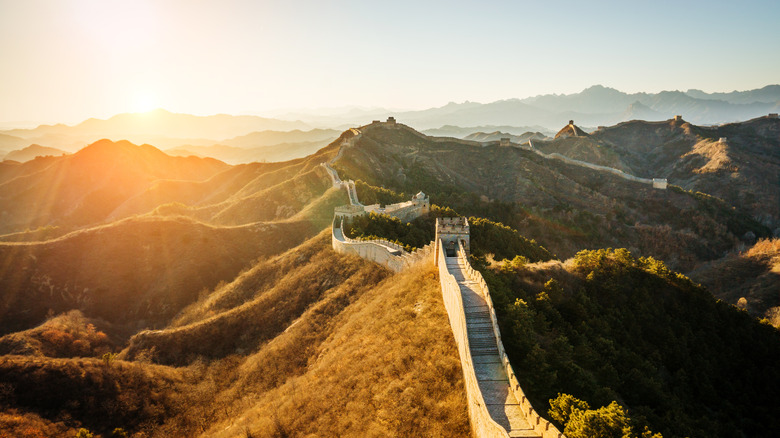Why You Should Add The Great Wall Of China To Your Bucket List
The Great Wall of China, regarded as one of history's most astonishing architectural feats, winds its way through the vast expanse of China's northern territories. Stretching over 13,000 miles, this ancient barricade was constructed to protect Chinese kingdoms from invasions, maintain border control, safeguard the Silk Road, and more. In 1987, UNESCO recognized it as a World Heritage Site, noting its historical, military, and architectural significance. If you are planning on traveling to China, the Great Wall deserves a spot on your bucket list.
Venturing upon the Great Wall is to step back in time. The Wall's construction spans several dynasties and centuries, with its earliest sections dating back to before the seventh century BC. Walking its path, you'll be treading the same ground where soldiers stood guard, beacon fires burned to signal invasions, and history was written in stone and sweat over the past 3,000 years. It is estimated that during the Qin Dynasty (221 to 207 BC), the emperor commanded 300,000 soldiers and 500,000 citizens to build the Wall — around 20% of the country's population at the time.
The architectural genius of the Great Wall is something to behold. The Wall isn't just a singular, monolithic structure but an intricate system of walls, trenches, and watchtowers (25,000 of them!), each designed with precision and monumental ambition. Its construction techniques evolved from the early Western Zhou Dynasty (1046 to 771 BC) to the Ming Dynasty (1368 to 1644 AD), reflecting continuous advancements in both design and materials.
Get your steps in on the Great Wall
The longest wall in the world offers a unique trekking experience. Whether you're a seasoned hiker looking for challenging terrains (check out the Jiankou section) or someone seeking a gentle stroll (Jinshanling would be perfect), there's a section of the Wall that's right for you. While some parts have been restored and are frequented by tourists, others lie in ruins, reclaimed by nature and offering an untamed exploration opportunity. If you plan to hike the entire Wall, plan about 18 months for the journey!
Because the Great Wall crosses nearly half the country, it's an excellent opportunity to experience the diversity of China's landscape, from the Gobi Desert to the Bohai Sea. The Mutianyu section is the best-restored architecturally and offers sweeping mountain views. The Huanghuacheng section is unique for its scenery — some parts are literally immersed in water! To see where the Wall meets the sea, visit Shanhaiguan. Although it's home to the Great Wall Museum, you might want to stay away from the Badaling section if you want to avoid tourist groups — it can see up to 65,000 visitors a day.
The Great Wall also provides a deep dive into Chinese culture. Along the Wall and in surrounding communities, you can encounter vendors selling handicrafts or taste local delicacies at restaurants such as The Schoolhouse at Mutianyu. Depending on when you go, you could witness events such as the Great Wall Red Leaves Festival (held annually in October and November) or the Great Wall Marathon that happens every third Saturday of May.
Visiting the Great Wall: When, where, and how
Adding the Great Wall to your itinerary is straightforward and affordable. Several sections, notably Huanghuacheng and Mutianyu, are only a 90-minute drive from Beijing. Organized tours ($75 to $150 for a one-day tour), public transport (around $7 by bus, round trip), and private hires are readily available, making it easy for travelers to visit. Entrance fees to the Great Wall vary by section and season, but the average price is between $4 and $9. The unrestored Jiankou section is free to enter — no gift shops or tour groups, just a 45-minute hike up the mountain and 12 miles of rugged wall terrain.
An ideal time to visit is during the autumn months, when the weather is comfortably cool and the fall foliage provides a picturesque backdrop. While spring offers mild temperatures and blooming nature, summer can be hot, humid, and crowded. Winter is serene with fewer tourists, but it can be bitterly cold, with some sections potentially inaccessible due to snow. It's also best to avoid major Chinese holidays when the Wall gets very crowded.
The Great Wall of China is more than just a wall — it's a journey through time, a testament to human history, an architectural wonder, and one of the world's best places to put on your bucket list. No wonder more than 10 million people make the journey to walk its ancient ramparts every year.


